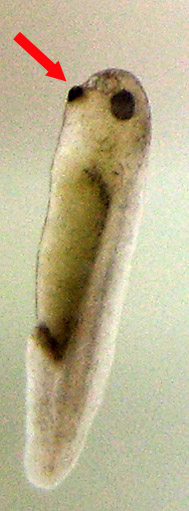Xenopus laevis is the latin name for the African Clawed toad
Hatching
After two days in the egg Xenopus are about 5mm long and have usually hatched. Like the British frog tadpoles (Rana temporaria) they then hang about for a day or so doing very little. They stick themselves to plants or other objects, like the side of a tank, with mucus secreted by a black cement gland on the head where the mouth will form (red arrow).
The mucus is not very strong, so periodically (on average once every 30 minutes) they come unstuck and fall through the water. In shallow water they may come to rest on the bottom.

Swimming
If not attached by mucus, tadpoles often start to swim spontaneously but they will also swim if touched or stroked gently anywhere on the body with something which will indent the skin like a fine hair. During swimming the trunk muscles on each side of the body contract in alternation and contractions start at the head end. As a result, waves of bending pass from head to tail, alternating at from 10 to 25 Hz and driving the tadpole forwards through the water. Stronger and damaging stimuli to the skin (e.g. blue laser in the video below), a brisk water current directed at the head and dimming the light will also start swimming which can last for many seconds.
Stopping
Tadpoles can start swimming spontaneously or when they are stimulated but it is just as important that they can stop. This normally happens when their head and cement gland bumps into the surface of the water or some other solid object like a plant or the side of a dish (see video clip below). This kind of stimulus and the tension in the mucus strand when the tadpole is hanging attached have an inhibitory effect on the tadpole. While hanging, it never moves spontaneously and is much less responsive to stimulation. This ability to keep still may make it more difficult for predators to detect and eat tadpoles.
Xenopus laevis tadpole swimming stops when its head clashes into a petri dish wall. gridlines at the bottom of the dish are one millimetre apart. The tadpole swimming starts when it is dropped into the petri-dish.
Struggling
Like many adult fish, when a tadpole is grasped and held anywhere on its body it makes strong, slow side to side bends of the body to try to wriggle free. This is most reliable when the tadpole head region is held. We call this behaviour struggling (see the videos below).
Compared to swimming the frequency of the bending movements is slower (5 to 10 Hz), and the waves of bending move in the opposite direction, from the tail to the head. This can be seen more clearly when the video is slowed down by 8 times below:

